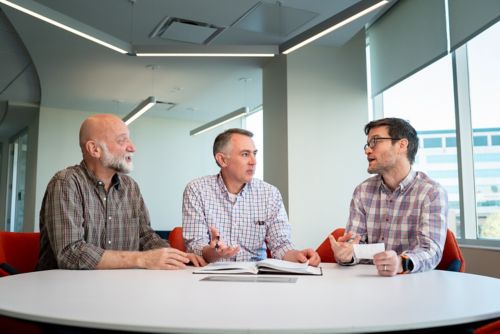St. Jude Family of Websites
Explore our cutting edge research, world-class patient care, career opportunities and more.
St. Jude Children's Research Hospital Home

- Fundraising
St. Jude Family of Websites
Explore our cutting edge research, world-class patient care, career opportunities and more.
St. Jude Children's Research Hospital Home

- Fundraising
Study reveals the neurochemical gatekeeper to learning and the key to unlocking it

Co-author Jay Blundon, PhD, first author Ildar Bayazitov, PhD, and co-author Brett Teubner, PhD, members of the Zakharenko lab, St. Jude Department of Developmental Neurobiology, demonstrated that diminished learning capacity over time occurs through increased sound-evoked adenosine release, and can potentially be reversed to restore neural plasticity.
In a classroom, as attention fades over the day, a teacher might need to employ some attention-grabbing tactics. A loud SMACK of a book on a table startles the room. The students’ minds are suddenly back paying attention…for the time being.
But why has our ability to learn organically diminished as we age, and what is it about a shock of attentiveness that reawakens the ability to internalize information? Research from St. Jude published in Cell Reports has outlined the chemical process in a neural circuit that permits this. The scientists found that sound-evoked adenosine release (SEAR) is the culprit for diminished learning capacity. They also identified activation of neuro-modulatory circuits such as dopaminergic and cholinergic receptors as vital in reversing this effect.
Why learning is child’s play
The brain’s ability to change and adapt throughout life is driven by its plasticity, the ability for neurons to form new connections, strengthen old ones or weaken others. In infants, it is a constantly shifting network, shaped and reshaped by the environment. As we age, our priorities shift. We are no longer purely learning about our environment; we interact with it.
“When you are at a party, you often want to talk to someone surrounded by other guests,” explained corresponding author Stanislav Zakharenko, MD, PhD, St. Jude Department of Developmental Neurobiology. “There is noise all around, but you want to pay attention to this one person and filter out everything else — to laser in on one information stream.”
The filter in place to allow this is adenosine. When we take in sound from our environment, the release of adenosine enables us to internalize only what we consider important. “Adenosine levels in the brain are very low in infants — almost non-detectable. But levels grow several-fold in adults,” Zakharenko said.
As he and his colleagues demonstrated in 2017 in Science, the release of adenosine reduces plasticity in neuronal cells, thus preventing connections from strengthening or weakening, hindering perceptual learning. Juvenile-like plasticity can be restored, however, through genetic disruption of adenosine production or inhibition of its target, the A1–adenosine receptor.
Fight-or-flight stimuli to recover plasticity
But why does the BANG of a book on a table reenergize the ability of a classroom to take in and learn information? This, as Zakharenko found, is due to the collaboration of two systems to induce plasticity, the sound-induced release of adenosine and the activation of neuro-modulatory circuits. Zakharenko described this phenomenon in mice, showing that acoustic stimuli induce the release of adenosine in the auditory cortex. This supplies adenosine to the brain but becomes diminished by the activation of dopaminergic or cholinergic receptors, permitting juvenile plasticity to occur.
“Plasticity happens if you remove adenosine from the equation. You can achieve this if you pair sound with activation of neuro-modulatory systems,” Zakharenko explained. “When a sound becomes significant, which is telegraphed by neuro-modulatory systems, the representation of how the sound is understood expands.”
The relevance of this is seen throughout nature. “If you’re a mouse in a forest and you hear the crack of a branch, several seconds of alertness makes this sound significant to you,” Zakharenko described. “The mouse learns from the situation.”
These findings establish the link between neuro-modulatory circuit activation and SEAR, adding one more piece of the puzzle towards understanding the development of our cognitive faculties. SEAR acts as the gatekeeper for cortical plasticity, and neuromodulator activation is the key to removing or opening this gate. The story is not complete, however.
“We characterized a connection between neuromodulator activation and adenosine release,” Zakharenko explained, “but we don’t fully know all the nuts and bolts of how these systems work together. We are exploring several possible mechanisms.”






